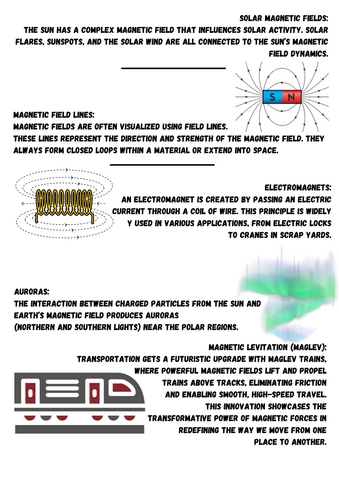Magnetic fields are fundamental to understanding the intricate workings of our physical world. These invisible phenomena have intrigued scientists and laypeople for centuries, from the mesmerizing dance of compass needles aligning with Earth's magnetic field to the sophisticated technologies that harness magnetic forces for myriad applications. But what exactly are magnetic fields, and how do they shape the world around us? In this exploration, we delve into the depths of magnetic fields, unravelling their mysteries and shedding light on their profound significance in our lives.

Understanding Magnetic Fields:
At its core, a magnetic field is the region surrounding a magnet, magnetic object, or electric charge where magnetic force is exerted. Think of it as an invisible force field similar to those depicted in sci-fi movies. But how does it function?
Origins of Magnetic Fields:
Magnetic fields arise from the movement of electric charge. With their negative charge, electrons move in certain ways, generating magnetic fields. These fields can manifest within the atoms of magnetic materials or within conductive wires, a phenomenon known as electromagnetism.
Measuring Magnetic Fields:
The strength and direction of a magnetic field are crucial parameters. They can vary greatly, from the Earth's large yet weak magnetic field to the intense fields generated by magnets. Proximity plays a significant role in magnetism; the closer you or the objects are to a magnet, the stronger its magnetic field will be.
Units of Measurement:
The strength of a magnetic field is quantified using units such as Tesla. Other terms like Weber, Maxwell, and Gauss are also used in electromagnetism to describe magnetic phenomena.
Visualizing Magnetic Forces:
Scientists often draw field lines to visualise the forces within a magnetic field. These lines depict the direction of forces at different points within the field. Additionally, techniques such as using iron filings allow us to observe the intricate patterns formed by magnetic fields around magnets.

Penetration of Magnetic Forces:
One fascinating aspect of magnetic fields is their ability to penetrate various materials. From paper to steel and even water, magnetic forces can exert their influence through many substances.
Exploring Magnets and Magnetic Fields:
Magnets, which can attract ferromagnetic materials and repel or attract other magnets, are ubiquitous in modern technology. Understanding the basics of magnets and their fields is essential for grasping their wide-ranging applications.
Magnetic Materials:
Ferromagnetic materials, such as iron, cobalt, and nickel, are strongly attracted to magnets. In contrast, non-magnetic materials like wood, plastic, aluminium, and copper do not exhibit magnetic properties.
Magnetic Poles:
Every magnet possesses at least two magnetic poles: a north pole and a south pole. Magnetic field lines flow continuously from the north pole to the south pole, creating a distinct pattern around the magnet.

Attraction and Repulsion:
The interaction between magnets depends on the alignment of their poles. Like poles repel each other, while opposite poles attract. This fundamental principle governs the behaviour of magnets in various configurations.
In Conclusion:
Magnetic fields, though invisible to the naked eye, profoundly influence the world around us. From the intricate patterns they create to their ability to attract and repel, magnets and their fields continue to captivate scientists and enthusiasts alike. Understanding the principles underlying magnetic phenomena not only enriches our knowledge but also unlocks a myriad of technological possibilities. So, the next time you encounter a magnet, ponder the invisible forces at play.


Interesting video about the sun’s magnetic field.
Source: https://www.nasa.gov/science-research/heliophysics/nasa-understanding-the-magnetic-sun/
